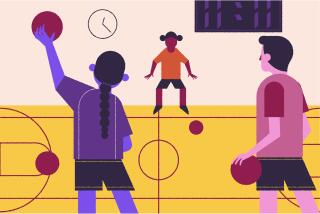Inner-City Youths Get With the Programs : While groups have poured money into activities after last year’s riots, questions about their impact remain. Organizers say involvement helps individual kids.
Since last year’s riots, calls for more positive alternatives for youths have increasingly focused on sports. At a glance, it appears that the calls are being heeded.
The Amateur Athletic Foundation, created after the 1984 Olympics to fund youth programs in Los Angeles, has committed $1 million to 26 youth sports programs in riot-affected areas. Announcements of corporate sponsorships of youth programs--for example, a $2.5-million youth center sponsored by singer Garth Brooks, the National Football League and the United Way and scheduled to open in June--continue to be made.
But while the altruism that has led more organizations to pour money for such programs into the inner-city has increased, questions about the effectiveness of the programs remain.
Program officials do not see them as a panacea to the problems of growing up in the inner-city. But the programs, they say, are making a difference in individual lives, and that is the first step toward a brighter future for many youths.
“Sports keeps me out of trouble because I spend my free time doing something productive,” said Jesus Vasquez, 13, a member of the White Sox baseball team at the Hollenbeck Youth Center in East Los Angeles. “I think the most important thing it teaches me is unity and to stay away from gangs.”
The Hollenbeck center, which has served the East Los Angeles community for more than 23 years, is among the programs often cited for making an impact in its area. Most notably, residents and participants in Hollenbeck’s programs say, the center has not ignored the deep-rooted anger and frustration that many youths bring into its programs, but instead finds ways to channel it in positive ways.
“We have kids that come in here with so much hate and frustration that they don’t have the patience to play the team sports (such as basketball, baseball and volleyball),” Hollenbeck field director Mike McClure said.
Therefore, many youths are directed toward boxing as a means of releasing their immediate anger. Such was the case with Ruben Palomares.
“I started out boxing because I wanted to be able to kick ass,” said Palomares, 23, who started training at Hollenbeck as a teen-ager. “But then I started to appreciate the science and I learned that I didn’t have to prove myself to be somebody.”
Nonetheless, Palomares proved he is somebody as a boxer. He won the California Golden Gloves Championships in the 106-pound weight class in 1986-87, at 112 pounds in 1989 and at 118 pounds in 1990.
Now, Palomares is a trainer and supervisor of the boxing program, which at 20 years is Hollenbeck’s longest-running, and perhaps its most effective, activity.
“The most important thing that boxing taught me, and the kids that participate in the program, is discipline,” Palomares said.
Part of Hollenbeck’s success in East L.A. can be attributed to its networking with the nearby Hollenbeck Division of the Police Department and citizens in the neighborhoods.
“I know a lot of kids that go (to the youth center) don’t get into trouble,” said Sgt. Helmud Kramer of the Hollenbeck Division. “For a lot of kids, it is the choice they need to keep them from finding mischief on the streets.”
For many organizations, getting the kids off the streets into their programs is difficult. But once the youths are in, the activities tend to become a focal point in their lives. Hollenbeck is not the only organization offering youths a choice.
The Kedren Community Health Center in Watts, for example, drew more than 1,500 youths to the Junior Olympics at the Kedren Center last June. The youths participated in wheelbarrow races, musical chairs, track and field, basketball, tennis, baseball, soccer and boxing and martial arts exhibitions.
“There were children lined up waiting to get in and register at 7 that morning,” said center spokeswoman Kitty Davis.
A similar turnout is expected June 19 for this year’s games.
Five-year-old Jerry Harper Jr., who will compete in this year’s boxing competition, has already been sizing up the competition. “I want to box because it’s fun,” Jerry said. “I think I can get a knockout.”
Kedren executive director Robert Owen hopes to instill in the children a philosophy that was ingrained in him by Edgar Ralph Jones, former president of his alma mater, Grambling State University.
“Jones told us that everybody is somebody . . . and if these kids feel that way, then they won’t give in to the pressure to turn to drugs or gangs,” Owen said.
Davis summed up best the importance of the Junior Olympics: “If we reached just one child, that is important because he could have been the kid that would have shot at me on the freeway.”
Thirteen-year East L.A. resident Jerry Santiago, who participates in youth programs at Hollenbeck, agreed that the programs are making a difference.
“Hollenbeck is the best thing going for kids around here because (the programs) give the kids something to do besides rob and steal. The activities allow the kids to feel like they have accomplished something and that makes them feel good. That makes the parents feel good and the pride is reflected in the community.”
More to Read
Go beyond the scoreboard
Get the latest on L.A.'s teams in the daily Sports Report newsletter.
You may occasionally receive promotional content from the Los Angeles Times.










